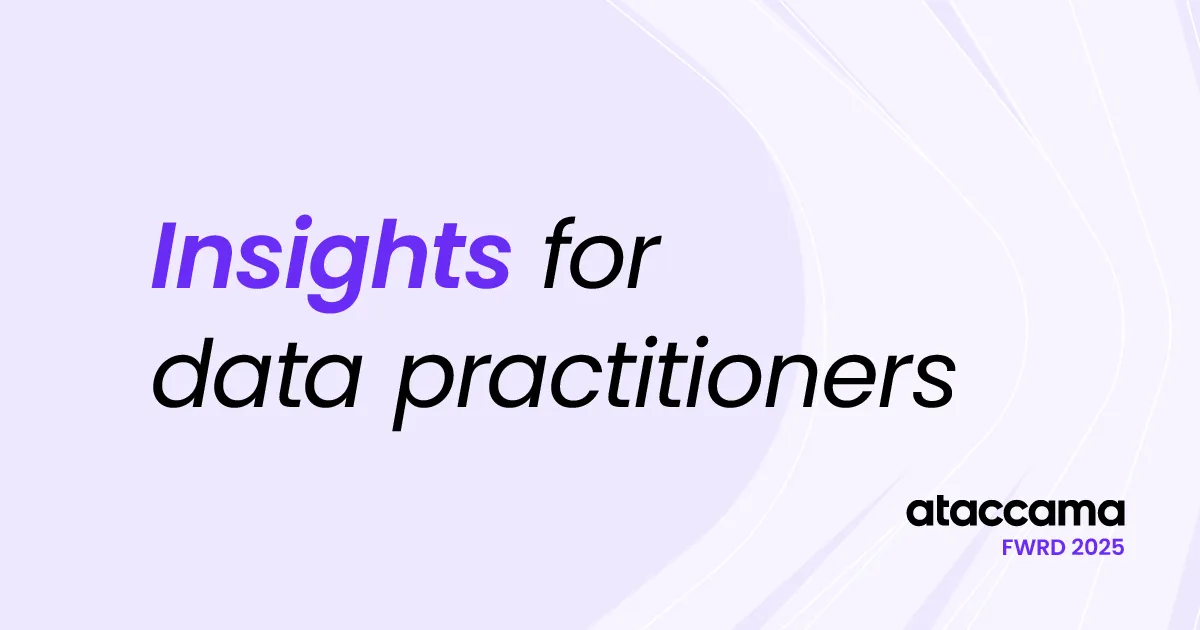Small Language Models: A Beginner’s Guide

A language model is a machine learning model trained to predict the next most appropriate word to complete a sentence or phrase based on the context of a given text. Language models grew in popularity thanks to the large language models (LLMs) like ChatGPT, launched in 2022.
However, many different types of language models exist, not just the most popular LLMs.There are statistical language models, neural language models, and small language models (SLMs), which are now becoming popular.
Small language models are a GenAI technology with a much smaller model size than LLMs. They are smaller because of their number of parameters (i.e., configurations), their neural architecture, and the amount of data used to train them.
The main difference is that they enable LLM-like capabilities with fewer parameters and required resources – an apparent reason behind their growing relevance.
Let’s explore SLMs, their benefits, and their future.
What is a small language model?
Small language models are AI that use machine learning (ML) algorithms trained on much smaller, usually domain-specific datasets.
Because the training dataset is smaller, the data quality is often better and more accurate. Small language models have fewer parameters (i.e., configurations) and a simpler architecture. Typically, anything below 30B parameters is considered a small language model.
What is an SLM vs LLM?
The main difference between an SLM vs LLM is the cost, complexity, and relevance.
An SLM is a type of AI model that uses natural language processing and is designed for specific tasks within a targeted domain. Trained on domain-specific data, SLMs are more computationally efficient, cost-effective, and accurate, reducing the risk of generating inaccurate outputs. Their smaller size allows for easier fine-tuning, making them highly adaptable. Unlike LLMs, SLMs are not one-size-fits-all models; they are intended exclusively for the domain they were created for.
What are some small language model examples?
Small language models come in many shapes and sizes. Let’s look at some specific examples of small language models to understand better what they are, how they work, and how they can benefit your business.
Domain-Specific Language Models
A small language model example is a domain-specific LLM tailored to a particular industry. It’s fine-tuned and trained on datasets specific to a field, such as healthcare or law, where specialized jargon and unique requirements are present.
Micro Language Models (Micro LLMs)
Another small language model example is the Micro LLM, which focuses on very narrow, highly specific datasets. By further refining the capabilities of larger LLMs, Micro LLMs offer enhanced granularity, providing improved personalization and accuracy. This makes them particularly useful in specialized fields like investment banking, asset management, and insurance.
Phi-3 Mini Language Model
A remarkable small language model example is Phi-3 Mini. With 3.8 billion parameters, it’s compact enough to deploy on devices like phones, leveraging filtered public web and synthetic data. This cost-effective model outperforms other models of similar size across benchmarks in language, coding, and math, making it a powerful SLM solution.
Key use cases for small language models
The critical use cases for SLMs are very similar to LLMs:
- Text completion and language translation. They can understand natural language and generate text, images, etc.
- Chatbots and virtual assistants. Especially in customer service, because they can assist and handle routine inquiries, and, as a result, they can enhance operational efficiency.
- Analysis and optimization. Sentiment analysis, data analysis, marketing, and sales strategies optimization (e.g., market trend analysis), and more.
In general, SLMs are particularly effective in scenarios requiring focused tasks with limited computational resources.
What are the benefits of small language models?
If you’re considering developing a small language model, here are some benefits to consider:
- Customizable. They can be customized for a specific use case (or at least it is easier to customize them compared to LLMs), such as building a customer-facing chatbot that will provide contextual and accurate information
- Less cost. The fact that they are small makes their costs small as well.
- Domain-specific. It is easier to fine-tune them with domain-specific data.
- More accurate and relevant results. Fewer hallucinations and bias and more consistent outputs because of training on domain-specific, high-quality data, and it is easier to fine-tune.
- Improved latency. Because they have fewer parameters, SLMs are faster and more responsive.
- Safety. You can train them on proprietary company data in your own environment.
- Fewer resources. They require fewer resources to implement, train, and run. In all senses: fewer people, less money, and less energy consumption.
Customization techniques for small language models
Since customizability is one of the primary benefits of SLMs, it makes sense to understand which elements are more flexible/adaptable and which customization techniques work better for each small language model use case.
1. Pre-training
This takes place during the initial phase of model learning and is typically unsupervised. In this phase, we expose the model to vast amounts of unlabeled text data to help it learn patterns in language, structure, semantic knowledge, etc.
Use cases: Text generation, language translation, sentiment analysis.
2. Fine-tuning
Further training the model on a specific task or domain. You take an existing model that someone has already developed and then train it on a dataset of labeled data for the specific task or domain. This improves the performance of the model for a specific task.
Use cases: Natural language generation, question answering (this is why those chatbots and virtual assistants need fine-tuning).
3. Architecture modifications
Ability to easily adapt model structure to niche tasks.
Use cases: Sectors like finance, healthcare, and supply chain management. E.g., patient management systems, medical insights assistants, personal assistants embedded in mobile devices
Security advantages for small language models
The smaller nature of SLMs also makes them easier to secure and mitigate risk. Here are some of the security benefits of SLMs:
- Harder to attack. Because they have fewer parameters and a more specific task focus, they are more contained, providing a smaller attack surface.
- Data privacy and security. Because the model is smaller, it makes it easier to secure.
- Deployment. They can be deployed locally or in a private cloud, meaning sensitive information remains under an organization’s control.
- Data exposure. There is enhanced privacy and a better ability to train them on proprietary datasets within a company’s secure environment, mitigating the risk of data exposure.
SML vs LLM: A deeper analysis of their differences
SLMs and LLMs are similar in architecture design, training, data generation, and model evaluation. But there are some significant differences between an SML vs LLM:
1. Size and model complexity
LLMs such as Meta’s Llama 3.1 contain 405B model parameters, while SLMs such as Mistral’s Mixtral 8x22B contain 8B model parameters — significantly less.
SLMs are smaller, so they typically have lower latency than LLMs when used for the same use case or task.
2. Contextual understanding and being domain-specific
SLMs are trained only on data from specific domains, making them excel in their domain (the domain they were developed for) as opposed to LLMs with vast knowledge of different domains.
SLMs lack this; they lack general knowledge, making LLMs more versatile. They can be adapted, improved, and engineered for a wider variety of downstream tasks.
3. Resource utilization
Training LLMs is much more resource-intensive, making it prohibitive for most companies to train their own. They require many GPUs and highly powerful and scalable infrastructure.
Training ChatGPT from scratch would require several thousand GPUs, whereas the Mistral SLM can be run on your local machines. Resource utilization is also about time. For all the reasons already mentioned, training an LLM takes much longer, typically months, whereas SLMs can be trained in weeks.
This leads to a much larger resource demand from LLMs, while SLMs’ limited resource needs make them more sustainable. Inevitably, all this affects costs—bigger model size = higher token cost.
4. Bias
Because LLMs are trained on large data sets, often from different domain areas and scraped from the open internet, they are less likely to be adequately fine-tuned. Working with a lot of raw, public data from different domain areas makes them more likely to produce biased outputs (e.g., it may underrepresent or misinterpret different groups and/or ideas).
SLMs pose a lower risk of bias because they are only trained on smaller, domain-specific, carefully curated data sets.
5. Use case
Given the context above, LLMs are typically better for complex, sophisticated general tasks, while SLMs are for more specialized, domain-focused tasks only.
6. Inference
LLMs require a lot of hardware, GPUs, and cloud services, so they must run on the Internet.
SLMs can be so small they can run locally without an internet connection.
7. Control
If a company wants to use an LLM, it will need to buy it (purchase licenses) from an existing provider. If the provider decides to change the model parameters, the companies cannot do anything about it, and they are exposed to potential risks of model drift or catastrophic forgetting.
Because SLMs can be run locally and are easier and cheaper to develop, companies can do it themselves. They have greater control over the data that goes into the model, the changes, and everything else. However, for this, companies need to have good-quality, governed data first.

How does a small language model work?
Similar to LLMs, SLMs are built on transformer architectures and neural networks.
The key pillars of how SLMs work are:
- Knowledge distillation. A distilled knowledge from a pre-trained LLM is transferred to SLM, capturing just the core capabilities.
- Pruning. Removes less useful parts of the LLM, helping capture only the necessary capabilities.
- Quantization. Weights and their precision are reduced, making the model less computationally intensive and allowing for reductions in model size and memory usage.
SLMs are typically fine-tuned on domain-specific data sets, or techniques like RAG can be used to optimize performance and expand the knowledge base.
For this to work, high-quality and well-curated data is needed. Data quality significantly affects the model’s performance and reduces hallucinations. A good solution will help streamline data collection and curation, eliminate repetitive data cleansing, ensure data is fit for purpose, and help address data drift early.
How to build an effective small language model
Successful deployment of small language models can be broken down into four phases: design, development, deployment, and management and learning.

- Design phase. Collect and curate domain-specific data relevant to the model’s intended use cases.
- Development phase. Choose an appropriate model architecture and process data to optimize training.
- Deployment phase. Implement encryption, access controls, and other security measures to protect data integrity.
- Management and learning phase. Set up monitoring, continuously incorporate new data, and ensure the model learns from ongoing feedback to improve performance.
Real-world examples of small language models
Small language models have many industry-based AI business use cases. Let’s examine the following small business model examples and how they are used in finance, pharmaceuticals, manufacturing, and insurance.
- Finance. Automating customer services, information retrieval from private internal documents, personalized financial advice, portfolio management
- Pharmaceuticals. Text generation, enhancing financial oversight, clinical trial optimization
- Manufacturing. Quality control, predictive maintenance, process optimization
- Insurance. Automating claims processing, fraud detection, risk assessment
What are the limitations and challenges of using small language models?
The effectiveness of SLMs is dependent on quality data. Having enough data to train the model is also important, while having access to large enough training data sets may also be challenging. Beyond that, some of the other challenges related to SLMs are:
- Proper AI governance. Companies must ensure that the model behaves appropriately and remains aligned with its intended goals over time.
- Clear use cases. SLMs may struggle with more generalized tasks and have limited scope.
- Require skilled staff. Companies will have to invest in people with data science and ML expertise if they want to operate SLMs.
- Limited scalability. SLMs excel in small to medium applications, but if a company deploys them on a large scale over time, they may degrade and become less suitable.
Build your small language model with the best data possible
SLMs are an important part of the AI readiness boom, and they will continue to be on the rise. They have the potential to complement or, in some use cases, completely replace LLMs.
Advancements in model architectures and training techniques are on the horizon and hold great potential to improve SLMs and their effectiveness further. With their apparent benefits, SLMs can make language models more accessible to businesses and industries.
Want to build your language models on the best quality data possible? Visit our data quality for AI page to learn more.
Anja Duricic
Anja is our Product Marketing Manager for ONE AI at Ataccama, with over 5 years in data, including her time at GoodData. She holds an MA from the University of Amsterdam and is passionate about the human experience, learning from real-life companies, and helping them with real-life needs.







